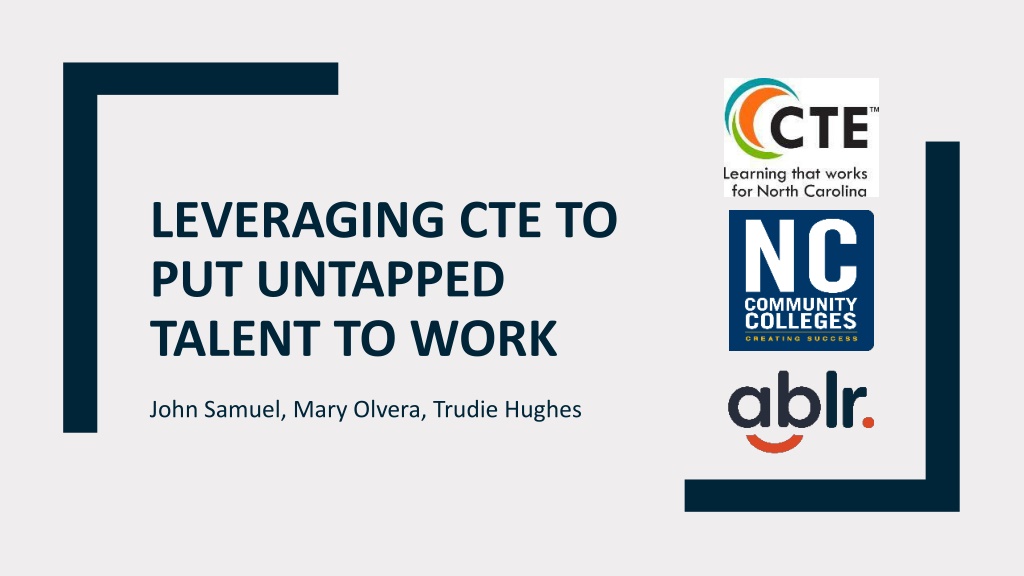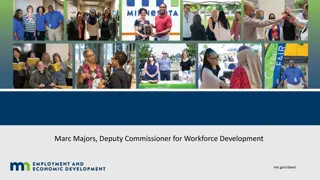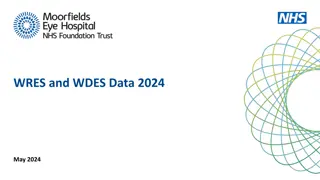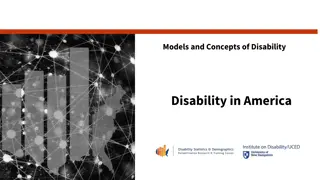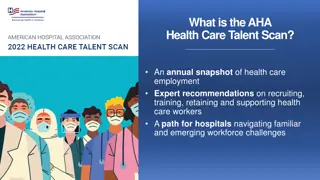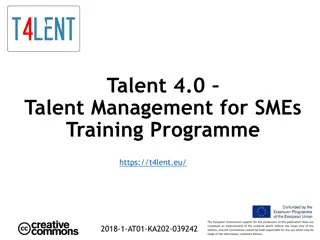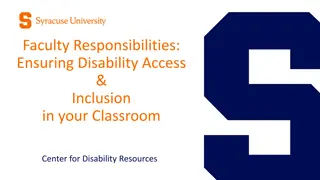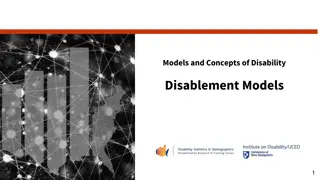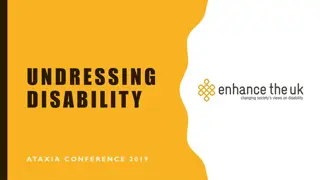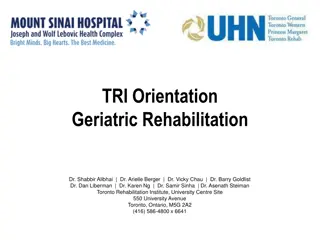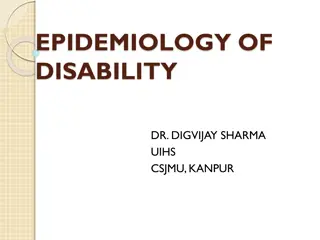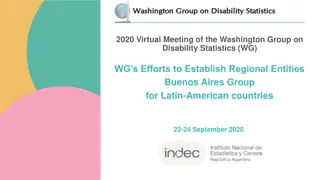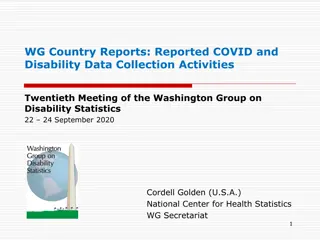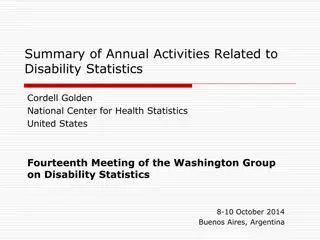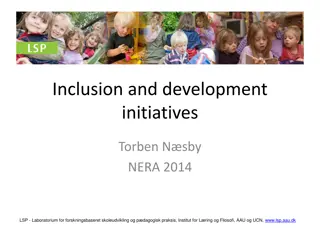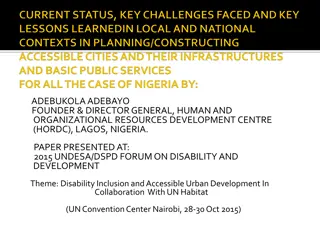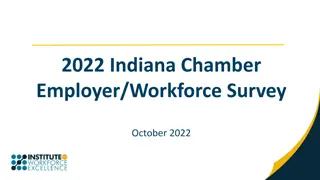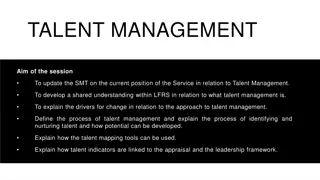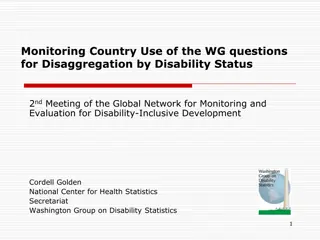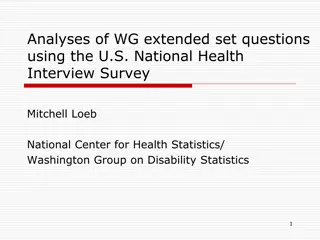Unleashing Untapped Talent: Transforming Disability Inclusion in the Workforce
Explore how leveraging Career and Technical Education (CTE) can empower individuals like John Samuel, Mary Olvera, and Trudie Hughes to contribute their talents. Discover the challenges and opportunities in disability inclusion, the impact of education and employment rates on individuals with disabilities, and the potential economic benefits of tapping into this diverse talent pool.
Download Presentation

Please find below an Image/Link to download the presentation.
The content on the website is provided AS IS for your information and personal use only. It may not be sold, licensed, or shared on other websites without obtaining consent from the author. Download presentation by click this link. If you encounter any issues during the download, it is possible that the publisher has removed the file from their server.
E N D
Presentation Transcript
LEVERAGING CTE TO PUT UNTAPPED TALENT TO WORK John Samuel, Mary Olvera, Trudie Hughes
Introductions Mary Olvera John Samuel Trudie Hughes State Director for Teacher Education, Public Services, and Perkins Special Populations CEO and Cofounder of Ablr State Director, Disability Services and Title IX
What is Untapped Talent? Why are we talking about it? Disability Inclusion: Preparing for the Workforce of Tomorrow Pilot Projects Results of the Pilot 1 & 2 Projects Next Steps: Leveling the Playing Field Takeaways for Today
Did You Know? 2x 61Mil. 63 80% Americans with Disabilities To the dollar More likely to live in poverty Unemployment Rate
Disability Employment and Education 26.7% 12% 32.8% Less than high school diploma Some college or an Associate s degree College graduates with Bachelor s degree 74.8% of graduates without disabilities were employed after graduation. (U.S. Bureau of Labor Statistics, 2024)
Trajectories of the Workforce 65.4% 2022 21.3% 2022 3X More Likely A person with a disability is unemployed 22.5% 2023 65.8% 2023 Employment rate for people with disabilities Employment rate for people without disabilities
Top Sectors for People with Disabilities: 8.4% Self-Employed Transportation Sales Construction
Economic Impact 2x 37% Less than what peers without disabilities earn Larger than the gender pay gap (Yin, Shaewitz, & Megra, 2020).
Economic Impact: Continued $25 billion $141 billion $6.5 billion 2011 potential earning of U.S. economy Potential income in federal taxes Potential income in state taxes
Untapped Talent How We Got Here Disability Inclusion: Putting Untapped Talent to Work Promotional Video Disability Inclusion: Putting Untapped Talent to Work Promotional Video
About Ablr Eliminating the digital divide Creating pathways for employment Changing mindsets of people and organizations Disability Inclusion Training Modules Disability Inclusion Consulting Services Digital accessibility services Workforce readiness and development programs
Module 1:Understanding Disabilities Module 2: Disability Etiquette Module 3: The Business Case for Disability Inclusion Module 4: Actions for Making your Workplace Inclusive Module 5: Adaptations and Assistive Technologies Course Modules
Project Purpose 1. Improve knowledge and skills in working with students with disabilities. 2. Enhance CTE programs, serve special populations and provide equitable opportunities.
What is Perkins? The Strengthening Career and Technical Education for the 21st Century Act (Perkins V). An act of the U.S. Congress that provides over $1.4 billion in federal funding that is awarded to states for support and enhancement of CTE education each year. The intention is to provide learners across the United States with opportunities to develop skills in every CTE career cluster and support students in earning certifications that will help them in their professional careers with specific considerations for serving identified special populations. People with disabilities are one of the special populations identified.
Measuring Success Performance on federal accountability indicators Size, scope, and quality of programs offered Alignment to local/regional labor market needs Progress toward implementing programs and programs of study Faculty & staff recruitment, retention, and training Progress toward improving access and equity Ultimate Success: In North Carolina, increase the number of people with disabilities enrolling and completing CTE education programs AND obtaining employment opportunities that provide a life-sustaining wage.
5 hours of self-paced content 30 engaging video discussions 5 interactive quizzes 5 slide shows 12 downloadable documents Components of the Online Course
Benefits to the Participants Maintain Culture of Inclusion History and Conceptual Models Respectful and Inclusive Behavior Business Benefits of Inclusion
Pilot 1 Requirements Write Letter Form Teams Complete Training Focus Group Complete Tests Reflect
Pilot 1: Participating Colleges Central Carolina CC Davidson- Davie CC Fayetteville Tech CC Cape Fear CC Blue Ridge CC Gaston College James Sprunt Nash CC Robeson CC Piedmont CC CC Rowan- Cabarrus CC Vance- Granville CC Wayne CC
Pilot 1: Participants by Area Participants by Area Vocational Rehabilitation AVP Work-based Learning Advising/Student Services/Career Counseling Distance Education/Instructional Design Deans Directors/Program Chairs Employers Disability Services Faculty 0 5 10 15 20 25
103 participants registered 89% completed the course Pilot 1: Course Outcomes Each participant completed pre/post assessments Three focus groups conducted 38 participants attended the focus groups
Pilot 1: Pre and Post Test Data 89.38% 68.77%
Pilot 1: Feedback We tend to check boxes; we need to be more intentional.
Pilot 1: Recommendations Curriculum Integration Deep Dive Resources for Faculty
Pilot 1: Next Steps I learned to be more mindful of how I use wording to create a learner-centered syllabus and inviting assignments for all learners. Language such as Student Hours instead of Office Hours puts the student first and creates an inviting environment for open dialogue. It has made me try to understand my employees and students more and allow for more inclusion and accessibility. Some of my employees have a hard time retaining information and found that it was health issues that were making remembering difficult. I am working with them to utilize notebooks and other things to help with their jobs.
Pilot 2: Requirements Write Letter Form Teams Complete Training Focus Group Complete Tests Reflect
Pilot 2: Participating Colleges New Participants Pilot 1 Participants Durham Technical CC Fayetteville Technical CC Cape Fear CC Beaufort CC McDowell Technical CC Forsyth Technical CC James Sprunt CC Gaston College Southwestern CC Richmond CC Rowan-Cabarrus CC Nash CC Stanly CC
48 participants registered 67% completed the course Pilot 2: Course Outcomes Each participant completed pre/post assessments Two focus groups conducted Survey sent to all participants
Pre and Post Test Data: Overall Average 89.21% 69.44%
Pre-test, Post test Results Cont. 1. Which of the following is appropriate, inclusive language for people with disabilities? o 58.91% to 93.44% 2. When working to create policies and procedures for greater disability inclusion, the single most important group to include is? o 34.11 to 74.59% 3. What is the size of the untapped talent pool of people with disabilities in the U.S.? o 31.01 % to 78.69%
Pilot 2: Feedback Real-World Experience Continuous Learning Expand Audience Beyond Online Platform
Pilot 2: Recommendations Develop videos or modules with faculty working with students with various disabilities. Offer practical situations for more diverse employment environments (educational institutions, factories, warehouses, retail spaces, restaurants, grocery stores, etc.) Train HR at colleges with these modules.
Pilot 1 & 2 Employers NC DHHS: Vocational Rehabilitation Henderson County Schools Person County Public School Hanes Brand Corning Inc. Gateway Wellness Foundation Stanfill Construction EBCI/ Health Care Robert Bosch LLC ST Engineering The Staffing Alliance Target
Pilot 1 & 2 CTE Subject Areas Represented Associate Degree Nursing Civil Business Technologies Allied Health Automotive Accounting Engineering Computer Integrated Machining Diesel/Heavy Equipment Electrical Systems Electronics Engineering Culinary Horticulture Industrial Systems Technology Human Services Technologies Information Technology Hospitality Management Livestock & Poultry Medical Assisting Early Childhood Occupational Therapy Pharmacy Technologies Economics Welding Nursing
Next Steps: Leveling the Playing Field Expansion Recruitment Employment Inclusion
Thank You! John Samuel john.samuel@ablr360.com Trudie Hughes hughest@nccommunitycolleges.edu Mary Olvera olveram@nccommunitycolleges.edu
Employment for People with Disabilities in NC According to 2019 data, there were: 232,875 people with all types of disabilities working in the North Carolina workforce (equates to a 33.8% employment rate) North Carolina ranked 42ndin the nation for employing people with disabilities (Medina, 2019)
